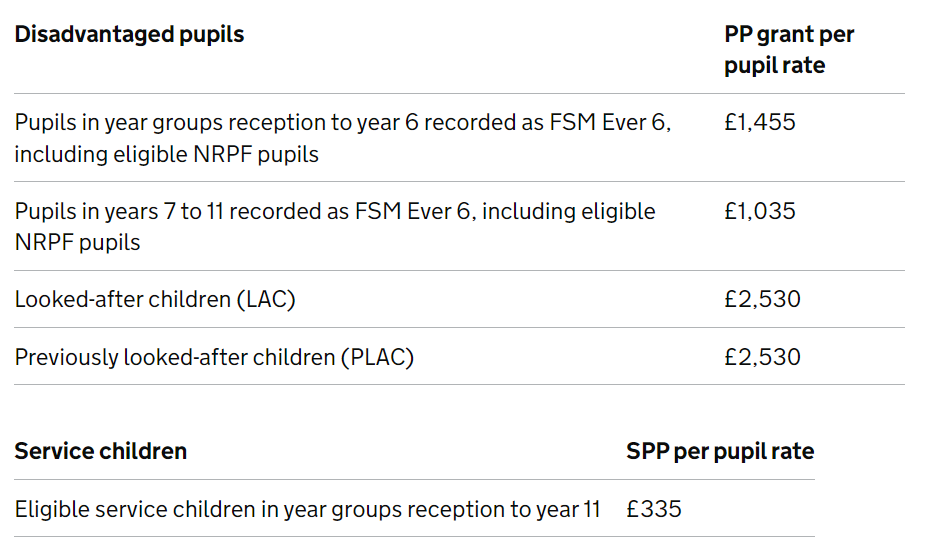Pupil Premium
Pupil premium is funding allocated to schools to improve education outcomes for disadvantaged pupils with the aim of diminishing the attainment gap between eligible pupils and their non-eligible peers. Funding is allocated to schools based on the number of eligible pupils on roll in the October school census; therefore, the funding amount allocated to individual schools has the potential to change each year.
The DfE advises that school leaders are best placed to assess their pupils’ needs and, drawing on evidence of effective practice, decide how to spend the pupil premium. Kemsley's Pupil Premium strategy details Kemsley's use of pupil premium funding to help improve the attainment of our disadvantaged pupils. It outlines our pupil premium intent, how we intend to spend the funding in this academic year, and the impact of last year’s spending of pupil premium funding.
Pupil Premium Funding 2023-2024
The table below show the amount of funding for primary-aged pupils for the academic year 2023-2024:

Statement of Intent
At Kemsley, our vision to ensure every pupil reaches their full potential is reflected in our school development plan and pupil premium strategy. It is our intention that all pupils, irrespective of disadvantaged circumstances, have an equal opportunity to be successful. Raising academic attainment of disadvantaged pupils across the curriculum through high-quality teaching (Tier 1) is fundamental to this strategy. However, we also recognise the contribution that targeted academic support (Tier 2) and wider strategies (Tier 3) make in enabling our pupils to fully participate in the curriculum, and develop the knowledge, skills, values, behaviours, attitudes, and cultural capital necessary for the next stage of their education and life in modern Britain.
Tiered Approach to Allocation of Funding
Our tiered approach for allocating funding aligns with the recommendations from the Department for Education and Education Endowment Foundation. Many strategies within the tiered model overlap categories, and the balance between categories varies from year to year as our school’s priorities change.

There is strong evidence that “what happens in the classroom makes the biggest difference... good teaching for all pupils has a particular benefit for disadvantaged students” (EEF Attainment Gap Report 2018); therefore, we allocate a large proportion of pupil premium funding to strategies that improve the quality of teaching and learning (Tier 1). Often, these strategies benefit all pupils.
Findings from the Education Endowment Foundation’s evidence reviews show that carefully chosen targeted academic support (Tier 2) has the potential to have a significant impact on pupil progress and attainment. Targeted academic support enables us to work closely with pupils in small groups to extend their knowledge and understanding, and develop their working memory. Additional recovery premium will enable an increase in targeted academic support in 2023-2024.
Wider strategies (Tier 3) relate to the most significant non-academic challenges, including attendance, behaviour, and social and emotional support, which may negatively impact upon academic attainment. We have invested the majority of our pupil premium funding on wider strategies, to support the funding of 11b411 challenges, free school excursions for pupils eligible for pupil premium and specialist support.
Four-step Approach to Development of the Pupil Premium Strategy
In line with Department for Education and Education Endowment Foundation guidance, we take a four-step cyclical approach in developing our pupil premium strategy:

1. Diagnose your pupils’ challenges and needs
A range of internal quantitative and qualitative data is analysed to identify common challenges faced by disadvantaged pupils at Kemsley. It is helpful to compare eligible pupils’ data with the data of non-eligible pupils and available external data to ascertain whether these challenges are prevalent amongst Kemsley’s disadvantaged pupils only.
2. Use strong evidence to support your strategy
Once we have identified the challenges and needs of our disadvantaged pupils, we seek relevant and robust internal and external evidence on which approaches are most likely to provide appropriate and effective solutions. We regularly refer to the work of the Education Endowment Foundation but carefully consider the relevance and applicability of the evidence alongside the specific contextual factors of our school.
3. Implement your strategy
Successful implementation of this strategy is a carefully staged process aligned with other school development plans and existing practices to ensure a sustained impact.
4. Monitor and evaluate your strategy
We continually monitor the progress of the pupil premium strategy, adapting the approach when and where appropriate. External monitoring is conducted by REAch2 Deputy Director of Education for Cluster 8 and by the Local Governing Body Pupil Premium Lead. The impact of the strategy is formally evaluated in the summer term and presented to the Local Governing Body for review. A revised strategy for the next academic year is published on the school website in the Autumn Term.
Please see our Pupil Premium Strategy for 2023-2024 attached below. At the end of this document, you will find the review of our Pupil Premium Strategy 2022-2023.
